Hot Pastrami on Pumpernickel: A Tale of Two Delis
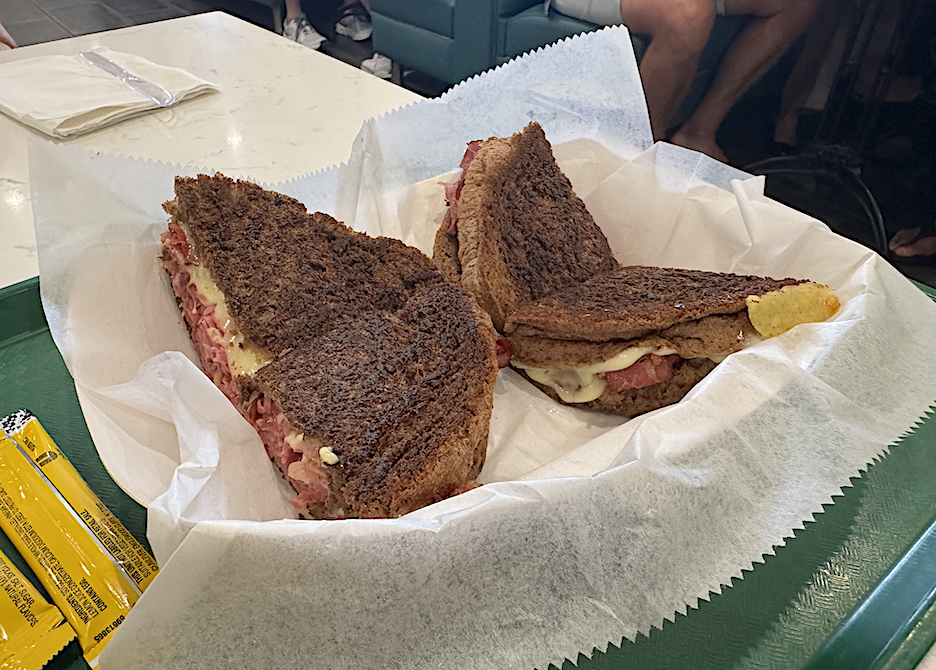
A friend and former teammate from high school in New York suggested featuring pastrami. It’s a sandwich I like but rarely get and never make. I’m more inclined to pastrami’s cousin, corned beef. But pastrami was tasty idea, and it stuck. We went out Wednesday afternoon and hit two delis in South Tampa for pressed pastrami sandwiches on pumpernickel: Wright’s Gourmet House (est. 1963), which stretches the notion of a deli, and Schiller’s German Delicatessen (est.1952). When I got home, it struck me: What, exactly, had I just eaten? Pastrami is a cured meat made with (usually) beef brisket, which is brined, seasoned, smoked and steamed. Despite its Italian-sounding name, pastrami originated in Romania — before refrigeration. WRIGHT’S GOURMET HOUSE I’ve lived in St. Pete for a very long time and worked in Tampa for extended stretches but had somehow never made the pilgrimage to Wright’s until Wednesday. The place is enormous. Two large dining rooms sit next to a massive deli area that has belted stanchions to manage lines — like TSA. I’d never seen that. At 12:30, we somehow missed those lines. When I ordered my $14 Hot Pastrami on pumpernickel (with “mustard sauce”), the counter person asked, “Would you like to add cheese?” I took that to mean it would be an extra charge, which turned out to be a dollar. (Hey, every dollar counts.) I got Swiss, passed on a side order. I gave her my phone number so staff could text me when my order was done. We sat at a two-top in a dining room that was nearly full and in about 10 minutes I got the ping and picked up the sandwich. Appearance Not pretty. Four dark-brown triangles sitting on paper. No acouterments. A dill pickle, maybe? Rye might have made for better picture. Taste and Texture The bread had a well-calibrated crisp on the outside, and a robust flavor. (It’d been a long while since I’d had pumpernickel.) The pastrami, sliced thin, was mildly chewy, but easy on the jaws. The Swiss, perfectly melted, oozed from the sides of the sandwich but not onto my fingers. All told, it made for a tasty return to hot pastrami. I ate half. Another one awaited. SCHILLER’S GERMAN DELICATESSEN Everything Wright’s is, Schiller’s isn’t, and vice versa. Located at the corner of El Prado and Manhattan, it appears to occupy a former convenience store. The Schillers no longer own it, and this is not the original location. Inside, the place is lined with shelves full of products, most of them German. Two young fellas — Eben, one of the owners, and Zack — were manning the shop. I talked NBA with Zack. When I find someone who can chat intelligently about the league — especially during the off-season — it’s an instant bromance (no slight to you hardcore women NBA fans; I don’t know any). I ordered the New Yorker ($9.95), which included Swiss, coleslaw, mustard and Thousand Island dressing. Zack and I discussed Paolo Banchero’s new contract and other NBA buzz while he made the sandwich. (He actually sliced the meat, like a real deli.) We sat at a four-top amid the shelves. I ate. Bonnie, not a fan of brined meats, did not. Appearance More of the same, only plainer. It became apparent that no matter how many flag-topped toothpicks or sprigs or other bibelots accompany a hot pastrami on pumpernickel, it’s still an ugly brown thing. I asked for and was happily granted a small container of sliced dill pickle. Taste and Texture Fresh off the press, the sandwich was hot when Zack handed it to me. The bread was impeccably toasted. The pastrami, laid on thick — but not so much that I had to unhinge my jaws — was just as tasty and a shade easier to chew than the competition’s. Purists might get the vapors over the thought of adding coleslaw to a hot pastrami, but I really appreciated the crunch and touch of sweetness the house-made stuff added. Somehow the Swiss cheese struggled to make itself known. Wanting to avoid a gut bomb, I ate half. Zack packaged it up nicely for later. And the Winner of the Hot Pastrami on Pumpernickel Competition Is … Schiller’s German Delicatessen. The sandwiches were about equal, although I give Schiller’s the edge due to the inclusion of coleslaw, however unorthodox. I generally avoid discussing price in FFF, but the Wright’s sandwich costing a third more than Schiller’s’ was hard to ignore. I admired the systematic efficiency of Wright’s, the mondo-deli’s ability to turn out a quality product quickly to such a large clientele. At Schiller’s I felt at home, even if it lacks the comforts. One last thing: Thanks for the idea, Doug.
Seeking Kernels of Truth: A Fracas Over Fried Rice
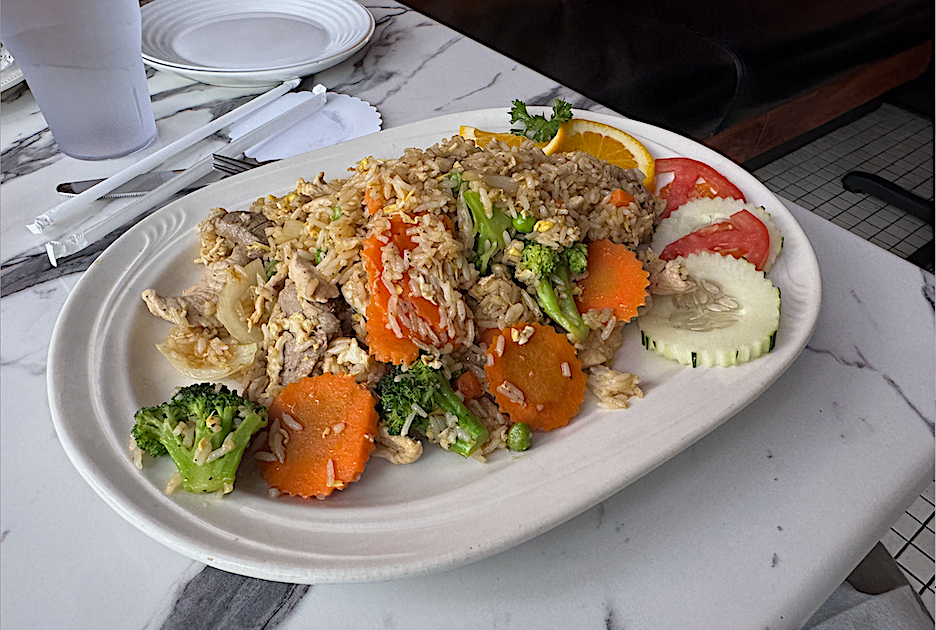
Fried rice — the gateway dish to Asian food — tastes good, it’s hard to mess up, it’s cheap, it’s fairly consistent from restaurant to restaurant. It’s also, um, unexciting. Can fried rice even be exciting? While it’s now a staple of most Asian restaurants, I first knew it as Chinese food. Fried rice did originate in China during the Sui Dynasty (589-618 AD), which is pretty specific as far as food history goes. We did not set out this week to find fried rice that wowed us. Why should it suddenly happen now? Instead, I wanted to pay close attention and see if I could detect subtle differences between two restaurants, neither of which turned out to be specifically Chinese: Moonlight Boba in Pinellas Park; and Pin on Grand in St. Pete’s Grand Central district. MOONLIGHT BOBA The little eatery with the romantic name is tucked away in a modernish building on US 19 just north of 62nd Avenue. We were the only customers at 6:45 on Monday. Moonlight Boba’s interior is sparsely furnished with little in the way of overtly Asian design elements. The well-lit place has a service counter in the middle, with high-tops on one side and low-tops on the other. Our smiling, quick-witted counter person, Ella, a college student, called herself a “bobarista.” We spent most of our meal chatting with her. I wanted to try three protein options — chicken, beef and pork — in my Hibachi Fried Rice. Because there was no combo price, this led to some tricky (and improvised) math — for a total of $19.98. Bonnie got Vegetable Fried Rice ($9). I also got a Mango-Strawberry Milktea with Honey Boba ($9.23). I’ll write a few words about my first boba drink at the end of the column. Appearance It never came up that we planned to dine in, so Ella brought out a stack of styrofoam to-go boxes in a bag. Bonnie grabbed a big spoon and crafted a photogenic bowl of fried rice. The above photo does not include large helpings of beef, pork and (especially) chicken that we portioned from the takeout box. The meal came with a container of creamy yum-yum sauce. Taste and Texture The rice clung together appropriately, not in clumps. The veggies — green beans, peas and carrots — were cut small. I wondered whether they’d been chopped up in-house or came from a frozen bag. (I didn’t ask.) Of the meats, I liked the pork, while Bonnie preferred the beef, which reminded her of the type in Philly cheesesteaks. The chicken was chalky, and we ate little of it. The sauce was, in fact, pretty yummy, adding a subtle sweetness. The protein-to-rice ratio was far too tilted toward the meats, and we left quite a bit in the box. In all, this was a solid portion of fried rice that I ate a good deal of. Bonnie easily finished her veggie version. PIN ON GRAND Thursday’s all-day rain had abated when we arrived at 6:30 under a dull white sky. The storefront’s only signage consisted of small, pink paper signs on the windows, and one on a tree out front, announcing “We’re Now Open.” Pin on Grand moved from a place farther east on Central to its new location in November. Inside, the place was busier than we’d expected, with many of the tables in the two rooms occupied, mostly with young folks. We sat at a four-top next to the window in the east room with a low ceiling that had an ornate chrome design that somehow wasn’t distracting. Pin on Grand’s vast pan-Asian menu ranges from sushi to ramen to Pad Thai. I ordered Thai Fried Rice with beef, chicken and pork ($23). Appearance For starters, this fried rice arrived on a plate. The meats were interspersed with the rice and large pieces of carrot, cucumber, broccoli, onion and tomato. The peas were smaller, as one would expect. In all, a more attractive presentation than most. Taste and Texture The rice was nice. It had a slightly more pronounced flavor than other versions I’ve had, although I’m at a loss how to describe it. Basil, maybe? In a reversal from Moonlight Boba, the chicken was clearly the star protein here — thinly sliced but still moist. The pork was okay, and the beef was rubbery. I added a few sprinkles of soy sauce to to punch up the flavors. And the Winner of the Fried Rice Fracas Is … Pin on Grand. This week’s fried rice lived up to its reputation, the one I outlined at the top of this column, although I wouldn’t consider our dishes cheap. That’s probably because I (ill-advisedly) ordered three proteins in each. I’ll most likely continue to get the dish from time to time, but going forward I’m ordering vegetable fried rice. About the Boba aka Bubble Tea: It came in a tall plastic sippy cup with a wide straw. Dark round globules gathered at the bottom — pieces of tapioca. When I sipped, the pearls rushed into my mouth along with the fruity, creamy liquid. It made me smile and actually blurt, “tapioca!” in momentary delight. These tapioca (there is no plural form, FYI) were bigger and chewier than the ones I’ve had in pudding, and after a bit I got a little weary of the jaw work, especialy seeing as I was consuming a beverage. At a certain point, I raised the straw above the pearls and concentrated on sucking in the sweet liquid, leaving leftovers piled on the bottom. I’ve no doubt that our bobarista Ella concocted a fine bubble tea. Will I return to boba-land? The jury’s out.
Daily Bread: Four Artisan Loaves (Ranked)
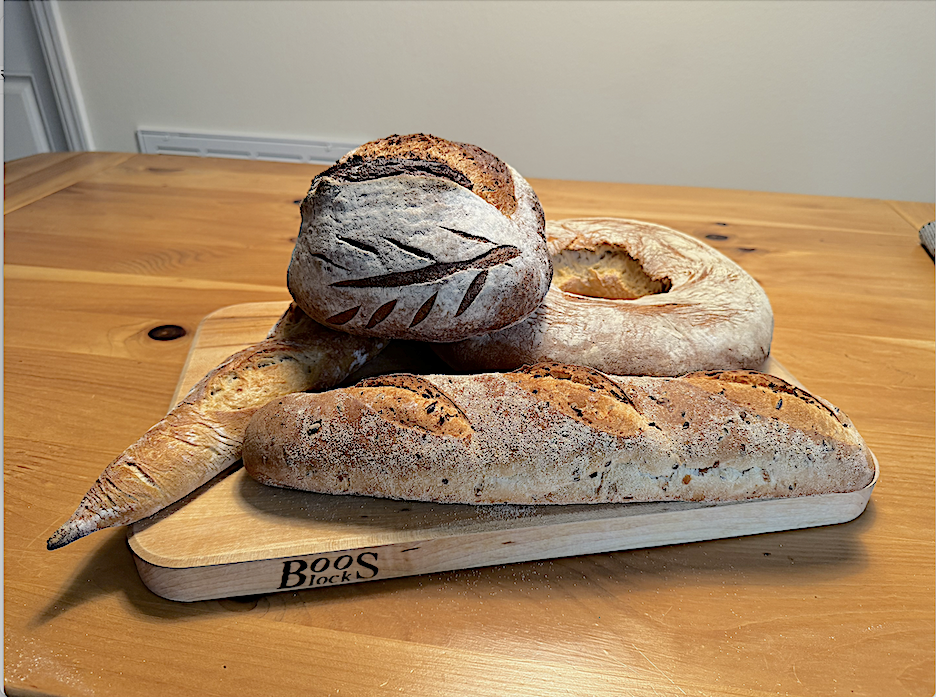
Bread and butter. Remember when it used to be our bread and butter? Then at some point, dips and spreads — fancier and fancier — became the norm, with butter melting to the wayside. When I have bread in a restaurant — complimentary; I’m a conscientious objector when it comes to paying for “bread service” — I’ll try the dip but usually ask the server for butter. It’s not a problem at home, where butter is the norm. But we rarely buy artisan bread. Too much hassle, too much travel. That’s why this week’s edition was so fun. Not too many places around here sell bread that’s fresh-baked on-site (I’m not counting Publix), but we found two bakery/eateries not too far apart: The Crumb Factory Bakery & Cafe in west St. Pete; and La Casa del Pane on St. Pete Beach. We made a morning run and picked up two loaves at each place, then brought them back to the FFF Lab + Photo Studio™. I’ll rank the four loaves at the end. LA CASA DEL PANE Translated from Italian, La Case del Pane = House of Bread. My food-obsessed, home-chef friend Dominic used to make weekly runs here from his home in Northeast St. Pete just to buy loaves, which made this cafe/bakery an obvious choice. The bread wall was at the back. Little signs said “No Sourdough” — not that they were out; La Casa doesn’t do sourdough. Our gracious and helpful counter person, Anna, explained that the day’s loaves were made from white flour, while on select other days the bakery uses semolina. Our eyes were drawn to a loaf shaped like a mega-donut that looked as if it was just pilfered from a an Italian farmhouse. We also chose a multi-grain baguette. THE CRUMB FACTORY BAKERY & CAFE The parking lot was full at 11:30, so Bonnie had to park across Central Avenue while I snapped pics. The bread case was just inside the front door. A line had formed to order the Crumb Factory’s coffee, sandwiches and other goodies. The counter staff was busy so we were on our own. All of Crumb Factory’s bread is sourdough. One loaf smiled at us — a big one with a wheat stalk branded into in it. We bit, then added a baguette. FFF LAB™ METHODOLOGY We waited until dinner. Cut chunks from each loaf. Warmed them in the stove. Sliced. Buttered (Land O Lakes with Olive Oil and Sea Salt, room temperature). Ate. THE BREADS La Casa del Pane Both of these breads had rustic, chewy crusts — my jaws got a good workout — and had airy insides. An appealing contrast. True to its appearance, the mondo-donut bread tasted straight from the farmhouse table. The multi-grain baguette had an easier crust, a somewhat more complex flavor and a few seeds for good measure. Crumb Factory The bread had a distinct, but not overpowering, sourdough flavor. The whole-wheat, smiley loaf yielded by far the largest, and darkest, slices. The crust was relatively soft, the interior denser than the slices from La Casa. The baguette slices were small and tear-able, ideal for dipping in red sauce. (No such luck for us; we were eating fish.) THE BREADS RANKED 4 — White-flour donut loaf from La Casa del Pane 3 — Sourdough baguette from Crumb Factory 2 — Multi-grain baguette from La Casa del Pane 1 — Whole-wheat sourdough smiley loaf from Crumb Factory This ranking is essentially superfluous, the differences were miniscule. But alas, the FFF bylaws require it. We enjoyed every bite of every bread we ate. This episode provided a exciting change of pace from our usual bread consumption. Please — do try this at home.
Crab Walk: Combing For Crab Cakes on The Pier
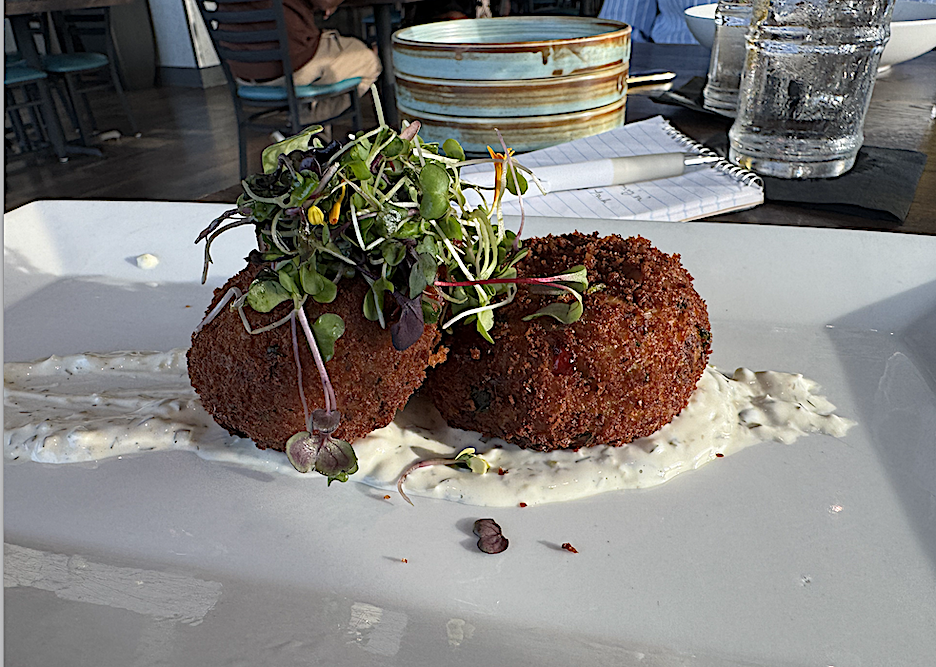
Thirty-two hundred feet. That’s roughly the distance between the two contenders for this week’s crab-cake title. One, Fresco’s Waterfront Bistro, sits at the very beginning of the St. Pete Pier. The other, Teak, occupies the top floor of the building at the very end of the Pier. Fresco’s, which has been around since 2003, has a beachy vibe with views of the Municipal Marina, where, over the years, the boats have gotten progressively bigger and grander. As for Teak, which opened in 2020, the optimal view is looking westward toward the St. Pete skyline, which, over the years, has gotten progressively bigger and grander. Both restaurants have crab cakes as appetizers. For good measure, we added a salad to each of our orders. FRESCO’S WATERFRONT BISTRO The preferred seating here is outdoors on the expansive patio. But it’s mid-June, so c’mon. Fresco’s has a charming indoor dining room, with planked floors and a curved bar in one corner. At 6:30 Monday, the AC was working just fine. We were the only customers in the room, but had the mild misfortune of sitting directly beneath a speaker pumping out ’80s music. It wasn’t blaring, but it was loud enough to make me cringe at “Love in an Elevator,” smile at “Wake Me Up Before You Go-Go,” and break into an after-dinner shoulder shimmy to “My Prerogative.” Our server, a young woman named Kim, was pleasant and attentive. I ordered the Crab Cakes ($22) and the House Salad ($11) with sesame ginger dressing. (Let me take a moment here to say that I appreciate restaurants that price in round numbers.) Appearance The crab cakes vaguely resembled burger patties ready for the grill. Not an ideal image, but not a problem, as I was all but certain they used crab meat. Plus they were drizzled with remoulade sauce. I was pleased to see a scoop of slaw on the plate. Taste and Texture The crust of the crab cake gave way easily to the fork. The lack of exterior crunch accentuated that the filling was on the mushy side of the crab-cake spectrum. The meat was mostly shredded, with little in the way of lumps, although the cake mixture was not over-breaded. All told, it had a pleasant flavor. After a bit, I started assembling bites with crab cake and the lightly mayo’d slaw, which provided tang and extra crunch. The salad featured a winning combination of greens, red onion, carrot shavings and tomatoes, sliced long and slender. (A small thing, but this method made the tomatoes less seedy, amplifying their flavor.) Bleu cheese crumbles on top were a welcome addition, as were the little pepita seeds. We had asked for a side of ranch, a safety valve if we didn’t care for the sesame ginger. The latter won the day. The ranch remained in its container, untouched. TEAK Well before this Wednesday dinner, we knew it was would be a success — that’s because we were joining our friends George and Diane, who we hadn’t seen in 40 years. At 6:30, we were seated at a four-top by the west-facing window. With the unfettered sun beaming through, management had lowered the translucent blinds to lessen the glare. Instead of waiting until the end of the meal and that potentially tense moment to see if someone reaches for the check, we quickly agreed to settle our own tabs. That’s a good way of doing it, people — even after four decades. Especially after four decades. We ordered Floribbean Crab Cakes ($20), a Teak House Salad ($16, full size); and Tuna Tar-Tacos ($24), for Bonnie. I got a 3 Daughters Beach Blonde Ale, 16-ounce draft ($7). Appearance The large rectangular plate made these brown orbs look kinda puny, but apparently that’s meant to exude a fine-dining vibe (which disqualified something as jejune as coleslaw). The crab cakes sat in a key lime remoulade and were topped by a cute cluster of micro-greens. Taste and Texture The crust was heartier than the competition’s, and there were more lumps of crab within. I liked that the filler included little pieces of pepper (red and green), which added mini-moments of brightness. While the cakes looked compact on the plate, their thickness made for a surprisingly ample app. The remoulade didn’t give off much key lime flavor, but all the same it made for satisfying dips. I’ve had the Teak House Salad before. I dug it then and I dug it on Wednesday night. It blends its greens with generous helpings of strawberries and mandarin oranges. The “roasted sesame pineapple ginger dressing” had a notable saltiness, which provided a welcome counterbalance to the the dressing’s overall sweetness. And the Winner of Combing For Crab Cakes on the Pier Is … Teak. A close contest between two contrasting restaurants. Both are well worth patronizing when you visit the Pier.
This Week It’s Poké … Okay?
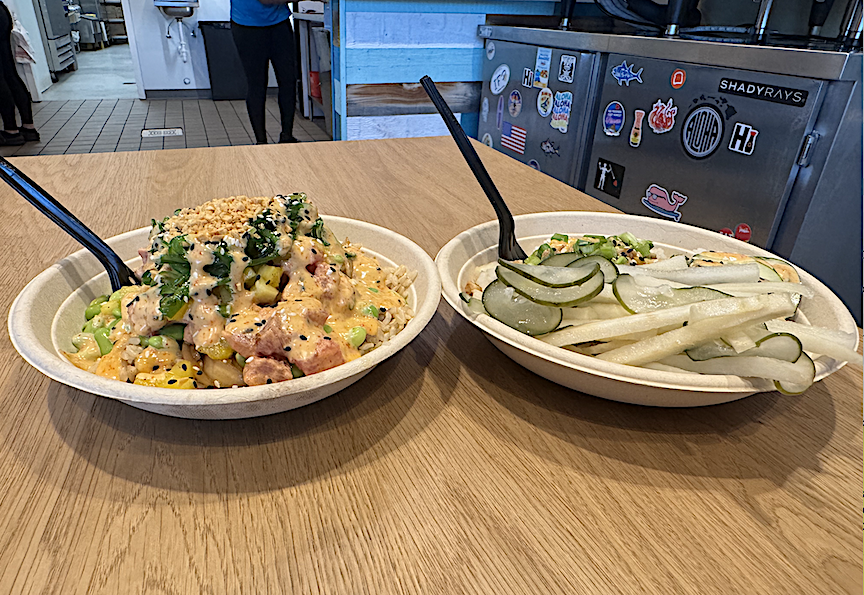
Recognizing that the word “bowl” was too generic, the bowl industry got smart and rebranded — to “poké bowl.” Pronounced poh-keh (say it quickly, with the accent lightly on the first syllable), it means “to slice or cut” in Hawaiian. What’s the difference between the bowls of a few years ago and the poké bowls of today? Not much, as far as I can tell.* I did a quick online search and found about a dozen restaurants in Tampa Bay that have “Poké” in their names. And the cuisine can now be called just “poké” — so you can say to someone, “Go for some poké?” And they can answer: “Okay!” Which is what we did. Our contestants are Island Fin Poké Company in South Tampa and Poke Island in Pinellas Park. ISLAND FIN POKÉ COMPANY At 7:30 Sunday, we parked right in front of Island Fin, which is located in a shopping center on Kennedy Boulevard between Lois Avenue and Dale Mabry. The vibe was bright and cheerful, made even more so by our two young servers, Alana and Kai. How Hawaiian is that? This South Tampa store, which opened in February, is the only Island Fin in Tampa Bay. The growing chain has 19 locations. Like most poké spots, the bowls are assembled cafeteria-style by the servers. Rather than going the build-your-own route, we chose two of the restaurant’s specialties: Spicy Tuna (with brown rice); and Korean BBQ Chicken (with white rice). Both cost $11, which I found more than reasonable. I added a Jaritos soda ($3), mango flavor. Appearance The cardboard bowls were well stuffed with stuff that looked altogether tempting. The presentation exuded health. Texture and Taste We shared our pokés, leaning across the table to take bites from each other’s bowls. I got the kimchi on the side because the girls cautioned me that it was spicy hot. Well, maybe a little. The kimchi’s zing banded together with pickled veggies to form a delightful complement to the cubed chicken, which wasn’t actually barbecued. Only the rice was warm. The X-factor was the white daikon radish, which came in long wedges that added delightful crunch. Overall, though, I couldn’t detect much Korean BBQ character. The Spicy Tuna — let’s call it mildly spicy — also had a winning combination of flavors, led by the cubed raw fish, accented by a sprinkle of crispy garlic on top. Brown rice provided earthiness. The X-factor here was a generous helping of edamame. I love edamame. Alana gave us each a small bowl of Dole Whip, a dairy-free frozen dessert, vanilla-pineapple flavor. It provided a refreshing cap to a lovely meal. POKÉ ISLAND Poke Island shares a small shopping center with a Wingstop and a Subway on stretch of 66th Street north of 62nd Avenue that was all but traffic-free at 6:30 Tuesday. Poke Island has a few specialty bowls, but our genial server, Van — who’s part of the family from Southeast Asia that owns the restaurant — suggested we use the build-your-own model. More options, better value. We chose the Spicy Tuna ($14.49) with white rice, and Fried Chicken ($12.49) with brown rice, and added Seaweed Salad to each for $1.50 per. It was fun walking down the line picking this and that (edamame!) to go along with our proteins. Appearance Size, would it matter? These bowls looked bigger than the one at Island Fin. (We checked when we got back to the FFF Lab + Photo Studio™, and this bowl was nearly an inch deeper.) Taste and Texture A surprise star emerged: the fried chicken. The crust was perfect, the white meat inside succulent, and there was lots of it. The bird played well with edamame, corn, cucumber, shredded carrot, seaweed and probably some other stuff I neglected to jot down. Bonnie’s plastic fork kept sneaking across the table to grab a piece of chicken. One more attempt and we’d have gotten into a plastic fork fight. Like Island Fin, this spicy tuna didn’t have much heat (certainly when compared to the versions I’ve had at sushi places). We had selected mostly the same veggies as the chicken bowl, with the addition of jalapeños, which didn’t add much to the spicy quotient either. This is not a complaint, just as observation. And the Winner of the Poké, Okay? Challenge Is … Hem. Haw. Poké Island. This was effectively a toss-up. We greatly enjoyed our meal at both places. They exuded health. Just what the (my) doctor ordered, after a few weeks of less-than-healthy FFFs. Each used a soy-based poke sauce and spicy mayo that were essentially identical. I appreciated the pickled veggies at Island Fin, and the complimentary Dole Whip, but the decision ultimately came down to that fried chicken. * On. Dec. 16, 2022, I published Battle of the Bowls. I don’t recall my research turning anything up about poké. I could’ve missed something — Van said Poké Island has been open about six years — but this time around poké was ubiquitous.
A Salvo Into Soul Food: Collard Greens, Turkey Wings and All
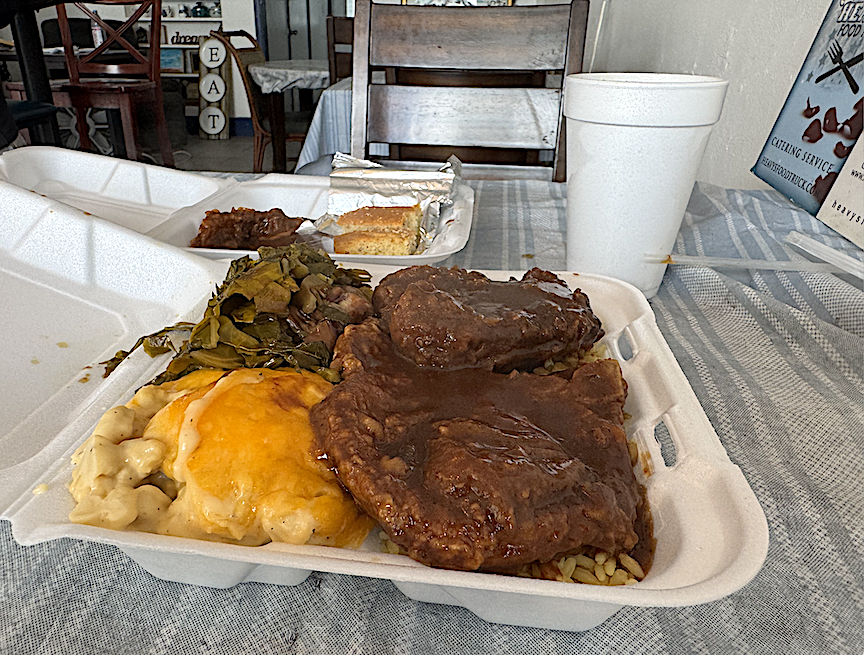
It seemed fitting that for this week’s edition on soul food we had to head South … 8 miles. From where we stay in northeast St. Pete, we drove to 22nd Street, crossed Central Avenue, and traveled the few blocks to 9th Street South, where we landed at Heavy’s Restaurant. The next day, we went 10 miles southwest to Gulfport and Baja’s Southern Cooking & More. I know my soul music. You might even say I’m an expert. Soul food. Not hardly. I know that chitlins and gizzards are non-starters. Collard greens and smothered chicken (and pork chops) — I’m in. Turkey wings? They’re something we throw out after Thanksgiving dinners. HEAVY’S RESTAURANT Wednesday’s all-day rain and general dreariness had begun to lift when we showed up at Heavy’s at 3 p.m. It’s located in a small commercial stretch of the former cultural nexus of Black St. Petersburg called “The Deuces.” Hip-hop music blasted from a courtyard next door. Worship City Church sat across the street in a block building. Just inside the restaurant’s front door was a counter lined with tins of food. Katrina — the friendly and loquacious front-of-house person — greeted us. She was more than happy to help us make selections, and provided us samples of short ribs and turkey wing, both of which were really good, the latter surprisingly so. We finally decided on smothered pork chops, and added a fried chicken thigh, also smothered, on rice, with two sides: collard greens and mac-and-cheese. I got a sweet tea, too. Sixteen bucks for all of it. We waited alone in the adjacent dining room that was randomly decorated. I was heartened to see an image of John Coltrane on the white wall, as well as the famous 1958 photograph, A Great Day in Harlem. Appearance It wasn’t pretty — but it wasn’t meant to be. Our late lunch came in two white foam containers, one stuffed well past the top. The meats were appropriately smothered in brown gravy; the sides looked seriously enticing. Taste and Texture It takes some work to cut a fried, gravy-drenched pork chop and a chicken thigh with a plastic knife and fork. But we probed and persevered, and were rewarded. The chop had that grainy, robustly chewy flavor that I remembered from my youth. The chicken’s thick crust gave way to moist and tasty meat. I’m a gravy man, and this dense brown stuff added a decadent, savory dimension. The mac-and-cheese was first-rate — thick and creamy, topped with a layer of melted cheddar for good measure. The greens were the most interesting of the lot. Katrina told us they’d been cooked in the juices of smoked turkey wings (bone nubs were in there to prove it). These collards, soggy but with a measure of crisp, combined tangy and salty with the slightest hint of sweetness. Baja’s Southern Cooking & More We arrived at Baja’s — situated is in a weathered strip mall on 49th Street and 18th Avenue South — at 5 p.m. Thursday. Two young women were schlepping go bags out to cars. When we pulled the door to walk in, one of them informed us that the service was curbside only — no dining in. Nothing on the restaurant’s website or social media specified takeout only. One runner — a nice young woman named May — explained that the owner was doing some remodeling inside. For the forseeable future, Baja’s is pickup only. Standing on the pavement, the sun bearing down on my black T-shirt as if through a giant magnifying glass, we ordered Smothered Fried Chicken ($16.59), with a mix of white and dark meat. The meal came with three sides. We chose mac-and-cheese and collard greens (to match Heavy’s), plus fried okra. We waited in the car for 20 minutes. May brought us our bag with a smile. Appearance Like the competition’s, not meant to be pretty. Also like the competition’s, a whole lotta food. The separate container of okra was enormous for a side dish. Taste and Texture By taking the meal back to the FFF Lab + Photo Studio™, we had the advantage of dishing it out on plates and using actual silverware. That made for less hunting and guessing, and easier slicing. The white-meat chicken stood out; it was remarkably moist sans the skin, which I peeled away. The gravy was a touch thinner than the Heavy’s stuff, but still dark and rich. The mac-and-cheese was thick and gooey, just as it should be. The greens were fine, but too salty for my liking. We popped the lightly breaded morsels of okra into our mouths by hand. And the Winner of Salvo Into Soul Food Is … Heavy’s Restaurant. The meals were similar. I found out that Baja’s’ owner, Rob Lancaster, used to work at Heavy’s. Heavy’s had the edge on sides. The mac-and-cheese had the slightest hint of sharpness, and the juices from smoke turkey wing in the collard greens made them sing. It helped that underneath all the smothered stuff was a bed of yellow rice. Baja’s, in turn, took the chicken honors. (We didn’t get a pork chop there.) And their cornbread was moist and yummy. Another factor was vibe. Eating at Heavy’s was an experience. We hit a part of town we don’t often go to. Hung out and chopped it up with Katrina. Our late lunch at Heavy’s offered the kind of fun that we couldn’t get from curbside pickup. An example: After we finished eating, I said to Katrina, “Y’know, white people don’t eat turkey wings. We throw them in the garbage after Thanksgiving dinner.” “What?!! she replied, truly gobsmacked. “Why?” I couldn’t offer a viable answer.
Fish Story: A Rumble Over Red Snapper
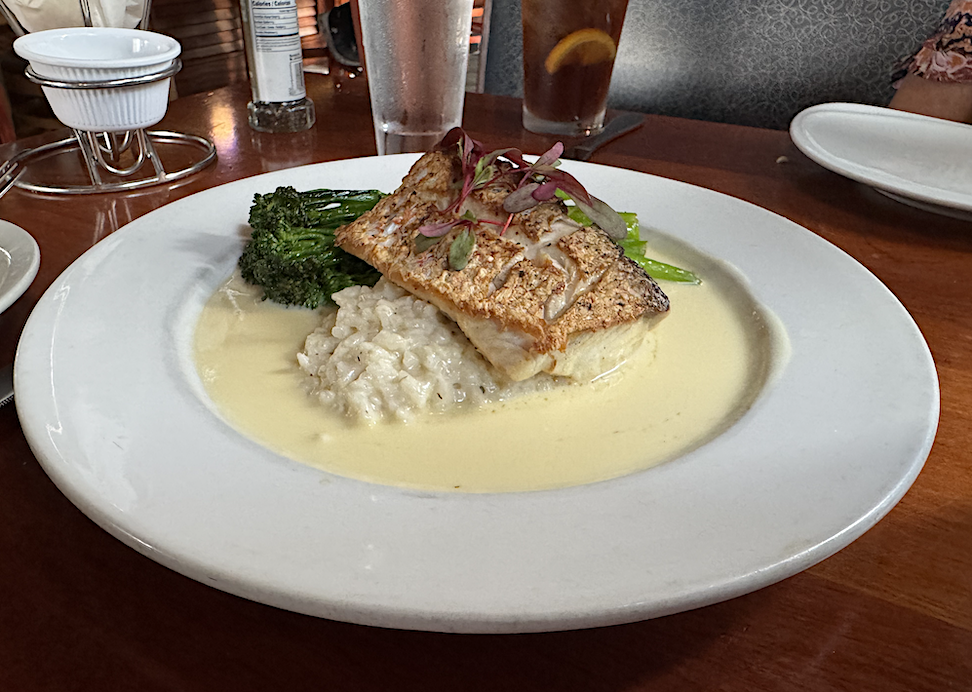
Red snapper takes the silver medal. It’s the second-most landed local fish, and probably the second-most lauded, behind — you guessed it — grouper. I didn’t just wing it on this factoid, but rather checked with an expert: my friend Earl “Buck” Lynge, who worked in wholesale seafood sales in the Bay area for three decades. For this week’s red snapper standoff, we lit out for St. Pete Beach and patronized two restaurants a half-mile apart: MadFish and Snapper’s (how could we not?). Both places serve snapper pulled recently from area Gulf waters. MADFISH As if its chrome coating doesn’t give it away, MadFish used to be a diner. But that was a long time ago. At 6:15 Tuesday, we walked up several steps to the entrance. We found out later that the restaurant is built on a raised block so was spared damage from last year’s hurricanes. Kudos to MadFish for going easy on the nautical design. The interior consisted of a handsome eight-seat bar that faces the door and a line of booths on the opposite side of the narrow dining room. Woods in different hues played well against the black-and-white check floor. We made ourselves comfortable in a booth and immediately struck an easy rapport with our server Daniel (not Dan or Danny), who was clad head-to-toe in black, including his logo’d ball cap. We decided to split the Red Snapper ($32.95) and a Wedge Salad ($14.95). Appearance Gorgeous. The snapper, with its enticing crust, sat regally atop a bed of risotto and broccolini. It all luxuriated in a pool of French beurre blanc sauce. The salad included the better part of a head of iceberg lettuce cleaved down the middle. Taste and Texture Heavenly. The pan-roasted snapper’s delicate crust provided a light chewiness and little bursts of salt that brightened the overall flavor. The flesh inside was flaky but not to the point of falling apart. It had a meatiness to it that we appreciated. I’m not typically a risotto fan, but this version slayed — the soft rice kernels retained their shape, avoiding the dreaded mushiness. The broccolini, which came in long stalks, provided able accompaniment. Tying it all together: the velvety sauce — not too thick, and with the slightest hint lemon. As for the salad: It was fine, but it was a lot. I’m not one to complain about too-large portions, but this was too much. It is, after all, called a wedge salad, not a head salad. I asked Daniel for some extra bacon bits and bleu cheese sauce, and he happily obliged. We took a lot of salad home, even though Bonnie informed me that she had bought two heads of lettuce earlier that day. I think there’s a cute little rabbit that makes its home near ours. SNAPPER’S The shiny, brushed-chrome sign makes Snapper’s easy to spot from Gulf Boulevard. When we arrived at 6:15 Wednesday, there was a 15-minute wait for a indoor seating, so we opted for a large table on the covered patio. It was warm, but the breeze and fans made it comfortable. The traffic noise wasn’t too instrusive. We established a friendly rapport with our server, Kayla, who actually told us fish stories. We were about to go with the Coconut Curry Snapper ($32.95), a regular menu item, when a special caught our eye: Snapper Sant’Antonio ($34.95), lemon pepper-seasoned in a broth of artichoke, lemon and capers. The entree came with a small house salad, so we ponied up the $4.95 upcharge and got one for each of us. Kayla brought us a (free) starter of cracker-like flatbread and zesty hummus. Good stuff. Appearance No crust, but no problem. The fish draped over a pile of jasmine rice. The yellow of the lemon gleamed in the sun during the photo shoot. Taste and Texture The snapper was broiled, which lent it a more even texture, meatier even than the version at MadFish. In my experience, fish generally goes better with lemon, and that was the case here. I also discovered that artichoke goes extremely well with fish — at least as pertains to this dish. The healthy chunks added a modicum of crunch and flavor sharpness. The rice, a little stickier than I prefer, nevertheless ate easily in clumpy forkfuls. Overall, a superb combination of flavors and textures. The salad was a winner — a simple mix of romaine lettuce and multi-colored crisps generously doused with a creamy, tangy mustard dressing that both of us liked. And the Winner of the Red Snapper Rumble Is … Hem. Haw. MadFish. This was a close to a dead heat as I can recall, but the FFF bylaws say no ties. My decision tilted MadFish’s way due to cooking method. I loved the delicate crisp of the pan-seared snapper. Snapper’s takes salad honors, and gets extra points for the flatbread-crackers and hummus. There’s another winner this week: Snapper. It’s better than grouper. Buck agrees. A final note: I chopped up the leftover salad from MadFish and scattered it in a corner of the yard. Do bunnies like bleu cheese dressing?
Electric Sliders: Two Vastly Different Restaurants Wrestle Over Mini-Burgers

Back in my teen years, when I was more apt to have coins than bills in my pocket, I occasionally indulged in the original sliders. We’d pull into a White Castle, get an oil-stained bag of the mini-burgers and scarf them down in seconds. We knew the greasy squares were not good for us — and we … did … not … care. For the record, it’s widely understood that sliders were born when White Castle opened in 1921 in Wichita, Kansas. The restaurant grilled small burgers on a bed of chopped onions, placed them in square buns, and sold them for a nickel a piece. Folks bought ’em by the sack. My White Castle days ended sometime in my early 20s, probably after a late-night stop there led to a wretched morning. Yet sliders have persisted and spread to restaurants of all stripe, and are no longer confined to burgers. This week, we sampled sliders at two restaurants that feature them: Tryst, a “Gastro Lounge” on Beach Drive in St. Pete; and The Kitchen at Mastry’s Brewing Co. on St. Pete Beach. TRYST Tryst never made it onto my FFF radar because I assumed it was more of a nightclub. Which it is — after dark. We arrived at 6 p.m. Tuesday and decided to dine indoors. The sidewalk seating was mostly full with young folks, while inside a few seniors were eating. Bonnie sat on a blue velvet banquette, me on a chair across from her. The place was cool and dark(ish). Contemporary dance music — but not, thankfully, thumping techno — played loudly, heavy on the bass. We ordered the Slider Trio ($18) and a Watermelon Burrata Salad ($18). Appearance Sitting on a wooden tray, the three sliders at first looked a tad meager, but on second thought I admired Tryst not fancying up the platter with useless bibelots that go uneaten. It was like: Want three sliders? Here’s three sliders. Burger, chicken, pulled pork. The salad consisted of an enticing bulb of burrata cheese dripping with balsamic glaze and four golf ball-sized pieces of watermelon on a bed of greens. Taste and Texture Starting with the burger, I wished there were more of it — not because it was puny but because it was so good I pined for a full-sized one. The beef, perfectly cooked medium-well, boasted a rugged crust and a juicy interior that induced a kind of flavor nostalgia in me that’s hard to explain. The pulled pork slider included nothing but the shredded meat soaked in sweet barbecue sauce. Terrific. The fried chicken slider was the most adventurous. A maple Buffalo sauce mixed sweetness and tang, and lent a scintilla of spicy heat. The fried bird, with a healthy crust, sat on coleslaw — an apropos accompaniment — rendering it the messiest of the three. A house-made dill pickle chip showed up about halfway through. A welcome surprise. The salad was a charming starter. The creamy saltiness of the cheese blend nicely with the refreshing crunch of the melon. THE KITCHEN AT MASTRY’S BREWING CO. We arrived at 7 p.m. Wednesday as musicians were setting up for open mic night. Even though Mastry’s Brewing sits on busy Blind Pass Road and has no water views, it maintains a decidedly laid-back, beachy vibe. Nearly all of the seating is outdoors under sails and umbrellas. The Kitchen is a food truck that blocks the dining/drinking area from the street. We ordered at the counter with a helpful server named Bari, who set us up with a sampler ($15) — one each of the three sliders. (Note: samplers are not available on the menu). I’d never had a Mastry’s beer, so ordered a Breezy Blonde ale ($7). The sliders came with fries so we skipped the salad. We sat at a basic four-top away from the stage. Appearance Not as elegantly presented as Tryst, but I had no expectation that it would be. I was hungry, and these sliders and fries certainly looked inviting. Taste and Texture The Smash Burger Slider was, true to its name, thinner and crispier than the competition’s. Smoked gouda cheese and a tomato added some flavor complexity. The Mahi-Mahi Slider melded the fish — which appeared to be lightly blackened — with veggies and smoked aoli. The most ambitous of the three was the BLAT! Slider, which included thick, crispy pieces of bacon, beer-battered tomatoes, vegetables and a “touch of fig glaze” (which I found undetectable). The ingredients mushed together for a flavor unto itself. The fries were thin and crispy, but lost their luster as they cooled, which didn’t take long. The Breezy Blonde was eminently drinkable — smooth, with just enough bite. And the Winner of the Electric Sliders Contest Is … Tryst. The downtown restaurant clearly went above and beyond to develop and deliver excellent, next-level sliders. About the name “sliders”: White Castle didn’t originally coin their nickel burgers as such, but they somehow earned the nickname. The restaurant ultimately copyrighted the name “Slyders.” One origin theory: In White Castle’s early days, the employees were clad in pristine white aprons and paper caps, and put on something of a show. The servers would slide the mini-burgers down the counter toward customers. Another origin theory: During WWII, U.S. Sailors ate mini-burgers that were greasy enough to slide down their throats. How that connected to White Castle is anyone’s guess. And a couple of final notes: Tampa Bay does not have a White Castle — never has, as near as I can determine. But it does have White Castle’s cousin, Krystal, with a location in Tampa on Hillsborough Avenue. I was pleased to discover that the White Castle I mentioned at the top of this column — in Nanuet, N.Y. — is still open. I don’t plan to dine there, or at Krystal, for that matter. If you’ve read this far, I thank you.
What the Cluck? A Chicken Cacciatore Clash
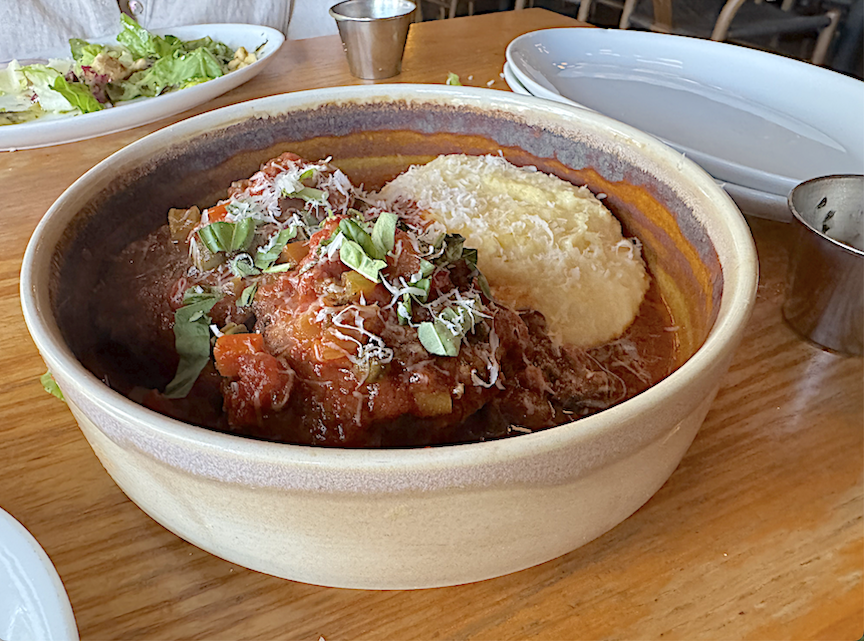
Of all the common Italian chicken dishes — parmesan, marsala, piccata among them — my favorite is cacciatore. (The one exception being my later mother’s chicken parmesan, which was in a class by itself.) When I set out to feature cacciatore this week, I found parmesan, marsala and piccata on nearly every menu, but had to spend copious time searching online to find two restaurants that serve cacciatore. That surprised me. True, there’s no Little Italy around here, but we’re not short on Italian restaurants. It’d be nice to see cacciatore on more bills of fare. Our two contestants are: BellaBrava, with three locations — St. Pete, Tampa and Land O’ Lakes — and Frankie’s Italian Chophouse in St. Pete. BELLABRAVA First, congrats to BellaBrava on its 20th anniversary this year. The restaurant opened on Beach Drive and 2nd Avenue — a block west of the St. Pete Pier — well before the area became busy with locals and tourists seven days a week. That activity proved true on Monday at 6:30. BellaBrava’s dining room steadily filled up during our hour-plus visit. We were seated at a cozy four-top next to a window looking out on 2nd Ave. It was splitsy night, so we ordered the Misticanza (mixed salad, $13.99) as a starter for Nona’s Chicken Cacciatore ($24.99). Minor complaint: The entree reached our table when we were about half way through our salad. Followed by a compliment: A plate of fluffy focaccia bread arrived shortly after we settled in — and it was free. A potent oil/garlic dipping sauce punched it up. A lagniappe much appreciated. Appearance Most chicken cacciatore I’ve seen has pasta beneath or beside it. This version uses polenta. Intriguing. It augured well that BellaBrava makes it cacciatore with chicken thighs rather than breast meat. Taste and Texture The polenta turned out to be a winner. Creamy rather than solid — similar in texture to grits — it mixed splendidly with the chicken, sauce, mushrooms, peppers, onions and whatever else. The delectable bird fell apart in layers. The red sauce was darker and more rustic than most I’ve had. In all, this sublimely savory version paid homage to the dish’s 14th Century origins as “hunters-style” chicken. The Misticanza was a superior house salad. Our server, James, brought us containers of Italian vinaigrette and honey basil dressing to try. The latter was so tasty that I didn’t bother with the former. FRANKIE’S ITALIAN CHOPHOUSE The last time I was in this building it was a gaudy Mexican restaurant stuffed with Day of the Dead iconography. It had horse saddles as barstools. Cute idea, horrible ergonomics. The place closed down in a blink. Frankie’s’ ownership remade the large space with a front bar and a dark dining room that celebrates its Italian-ness without going overboard on the Rat Pack vibe. At 7 p.m. Wednesday, the parking lot was nearly full, and so was the bar. But the dining room was all but empty. David Downing, my friend and frequent FFF consultant, joined me for dinner. We sat in a comfortable booth near a window. The sound system played mostly Motown, but at low volume, allowing us to chat easily. We ordered, to split, the Half-Chicken Cacciatore ($37), and added the Frankie’s Salad ($15), plus a Three Daughters Beach Blonde Ale for each of us. At $6 for a 16-ounce can, it was the best deal of the evening. I had two. Appearance An imposing mound of food sat in a shallow bowl. The chicken and spaghetti were barely visible, smothered in a red sauce that contained large pieces of pepper, onion and mushrooms cut in half. Taste and Texture I paused briefly to formulate a plan of attack — ultimately just plunging in with a knife and fork. I found a bone-in half-chicken and carved it to split with David. He ended up with the thigh and leg, me with the breast. We agreed after eating that it should’ve been the other way around. Whereas the BellaBrave cacciatore was polite and tidy, this version was random and messy — but not in a bad way. The sea of sauce had a winning sweet tinge, and the extra ingredients enhanced the flavor. My white-meat chicken was moist and tasty. The spaghetti was proved a little hard to get on the fork — buried, as it was, under chicken and sauce. The house salad consisted of chopped lettuce, a generous amount of cubed ham, pepperoni and cheese, plus slivers of egg and black olives, accompanied by ranch dressing. We scarfed it up. Alas, no bread. And the Winner of the What the Cluck?—Chicken Cacciatore Clash Is … BellaBrava. The polenta and the boneless thighs — and the focaccia — were the differentiators for me. It’s quite possible that the next person would prefer the bone-in chicken with the more traditional spaghetti. Both cacciatores were more than worthy. I found BellaBrava’s exemplary.
A Juicy Fracas Over French Dip
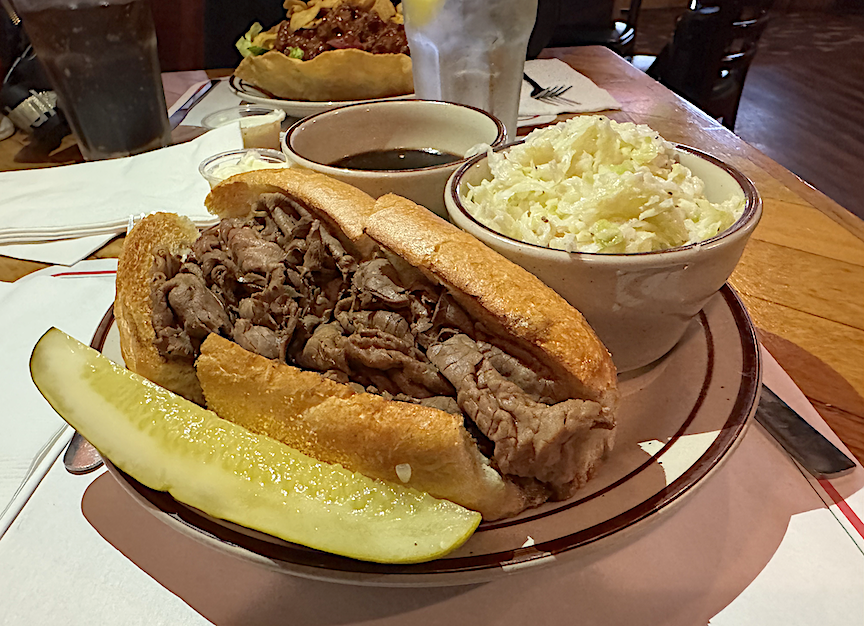
Here’s a shocker: The French dip isn’t French. It harks back to Los Angeles in the early 20th Century. Cole’s Pacific Electric Buffet and Philippe the Original — both of which opened in 1908 and are still in business — claim to have invented the sandwich, which features sliced roast beef on a French roll, served “au jus” (with juice), for dipping. Me, I’m going with Philippe. Sounds more French. And it’s “the original.” Although I do favor the Cole’s origin story: that a sympathetic chef added the jus for a customer complaining of sore gums. At any rate, the French Dip has endured. Over the years, most versions have come to include cheese (usually Swiss) and maybe grilled onions. Our two contestants are: Harvey’s 4th Street Grill in St. Pete and Miller’s Ale House, with two locations in Tampa and one in St. Pete (and 114 overall; I had no idea). HARVEY’S 4TH STREET GRILL I hadn’t been to Harvey’s in eons so was somewhat surprised to see it packed at 6:30 Tuesday. The place has been open since 1984 — which was probably about the time I first went — and it looks as if all ownership has changed are the lightbulbs. And why should they change? Harvey’s remains a go-to joint for denizens of northeast St. Pete — the senior set, if our visit was any indication, many of whom have likely been regulars since early days. I didn’t check IDs, but the eye test told me that there was one couple in the place under the age of 60. Harvey’s is dark and pubby, the kind of place where waitresses call you “hon’.” We managed to score a two-top in the main dining room. I got coleslaw as a side dish for my French Dip Sandwich ($15.70). Appearance This version resembled just about any French Dip ever served. The requisite bowl of deep brown juice elbowed its way onto the plate with the sandwich, the slaw and a big beautiful wedge of dill pickle. Taste and Texture I look for three basic things in a French Dip. Let’s do a Harvey’s checklist: Tender beef piled high, thinly sliced, with no gristle or fatty parts. Check. A fluffy roll that’s easy to chew. Check. A jus that’s full of potent flavor but not overly salty. Check. No check mark for the Swiss cheese, though, which made scant impression. And the onion was barely there (I could’ve used some more). The slaw was just how I like it: finely chopped, not too mayo’d, and with a hint of sweetness. MILLER’S ALE HOUSE We’ve driven by the St. Pete MAH, located in the Gateway Mall on MLK Street, innumerous times, but neither Bonnie nor I could recall ever going there. We walked in at 2 p.m. Thursday and what jumped out at us was how big this place is. Take out the booths and the bar and you could play some full-court hoops. The dining room, split in two by a sizeable bar, is floor-to-ceiling dark(ish) wood. We sat in a booth — there are mostly booths — near a window, and decided to split the Prime Rib French Dip ($17.79), with fries on the side (no coleslaw available). Inoffensive pop music played on a speaker over our table, but at a moderate volume. I did hear that 1974 yacht-rock chestnut by the band Ace … (We pause for a round of Name That Song) That’s right: “How Long” (“has this been going on?”). I survived it. Appearance No surprise, the sandwich looked similar to the one at Harvey’s — except: I could see onions. An encouraging sign. The fries were long and pulpy and flecked with pepper. Taste and Texture This sandwich checked all the same boxes as the one at Harvey’s. So, in all, an estimably edible French dip. There were a few differences. The beef was not shaved as uniformly as the Harvey’s sandwich, making it a little sloppier. While the cheese was all but undetectable, the onions were really there, adding a genial crunchiness to what is by nature a soggy sandwich. The jus was not too salty, but in an unexpected turn, I didn’t find it quite salty enough. This juice was a touch short on potency. The fries were first-rate, plump and and full of potato flavor. And the Winner of the Juicy French Dip Fracas Is … Harvey’s 4th Street Grill. By the thinnest of margins. Each sandwich was top-notch. I feel slightly bad having to choose a winner. But the FFF bylaws prohibit ties. And besides, as we like to say here at FFF: There are no losers, only runners-up. And this one was the closest decision I can remember. Maybe it was that big beautiful dill pickle.
A Crispy, Asian Duck Ruckus
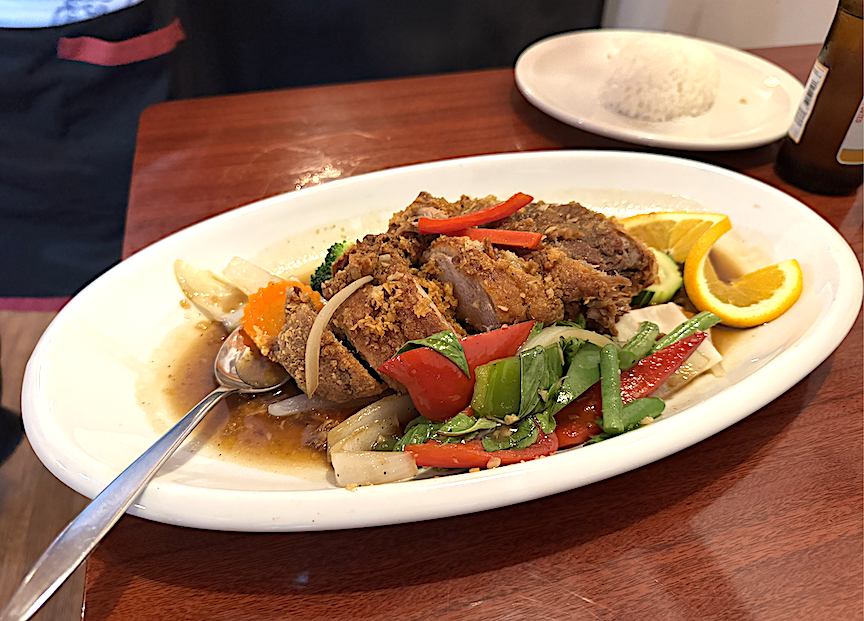
I came late to duck. As a suburban middle-class kid, I was about as likely to sit down to a duck dinner as drive an Aston Martin to school. During my adulthood, chicken did the heavy lifting, and I didn’t give duck much thought, other than not wanting to eat it. Then about a decade ago, on a trip to Santa Fe, N.M., a waiter at a French restaurant convinced me to try the duck confit. Turns out I liked it — quite a bit. Even so, 10 years on, I rarely eat duck, and only in restaurants. I’m traveling this week, so it’s another edition of Tampa Bay vs. the World: Crispy Duck at Pin Wok & Bowl in St. Pete takes on the Fresh Ginger Duck at Mana Ning’s Thai in Watkinsville, Georgia, just south of Athens. Different dishes, yes, but about as close as I could get. THAI WOK & BOWL Revelry — drunken or otherwise — was in effect as we walked north on Central Avenue toward Pin Wok & Bowl on Saturday. And it wasn’t yet 6:30. At one point, we strolled alongside an apparent bride-to-be, out on her bachelorette party, who couldn’t walk without the aid of two woman holding her elbows. Many happy returns. The restaurant, located on the 400 block of Central, provided a calm respite. The interior was basic in a good way, with little in the way of kitschy Asian signifiers. We sat at a two-person booth. The Crispy Duck ($27) comes with a choice of chili, Panang curry or Thai basil sauces. We opted for the latter, and added Basil Vegetable Fried Rice ($15) plus an order of Egg Rolls ($6). Appearance The dish had strong table appeal, which was a bit of a surprise in an unassuming eatery like PW&B. The reds, greens and oranges of the veggies really popped next to the enticing slices of brown duck. Likewise, the fried rice had an elevated presentation. Taste and Texture For starters, expert crispiness — kind of important when it comes to crispy duck. The rugged skin gave way to sumptuous meat that was perfectly cooked (sans pink, thank you) — tender, moist and rife with savory flavor. We chose well with the basil sauce, an understated brown nectar. The vegetables were deftly cooked, adding a salubrious flourish. An ample helping of onions joined the peppers, green beans, carrots and cabbage. Bonnie and I were duly impressed with the crispy duck, as we were with the fried rice, which was a few levels above the usual. MAMA NING’S THAI I’ve eaten several times at Mama Ning’s, which is located on Watkinsville’s quaint Main Street, while visiting my son’s family in Athens. The food has been consistently good — enough to make it our go-to Asian restaurant, be it takeout or eat-in. Our party of five — including my 4-year-old granddaughter — arrived at 6 p.m. Tuesday. The late-afternoon sun shone harshly on our table. Install a set of blinds, maybe? Along with my Fresh Ginger Duck ($21.95), Bonnie got Basil Stir Fry ($12.95). While waiting for our meals, we quizzed granddaughter on her letters, which she dutifully wrote into my notebook (and I later used for reference). Appearance The presentation was more stew-like than PW&B’s, with the morsels of duck strewn among the veggies. Different, but no less enticing. I didn’t spot peppers. I did spot mushrooms. Taste and Texture Although not touted as crispy duck, this version still had the crunchy skin, which I welcomed. Combined with the meat, it offered sublime chewability and luscious flavor. The vegetable pieces were smaller than the competition’s. The crinkle-cut carrots, in particular, made little impression. I missed the refreshing punch of the peppers. The ginger provided a potent flavor, an overall sharpness, considerably different than the easygoing basil sauce. And even though, I ordered “no spice,” I detected some agreeable heat. And the Winner of the Asian Duck Ruckus Is … Pin Wok & Bowl. A close decision. This ruckus came down to the vegetables. We preferred the bigger, more vibrant ones in St. Pete. The sauces provided a marked contrast, and I can’t say that I preferred one over the other. In fact, they made eating Asian duck twice in a week a pleasure. If you ever find yourself in Athens/Watkinsville craving Thai, head to Mama Ning’s.
Feudin’ Flatbreads
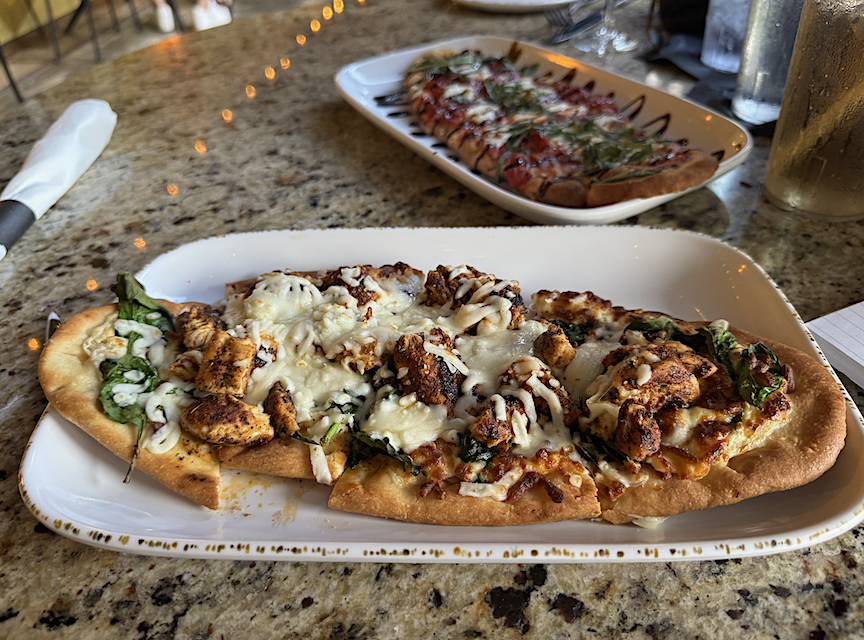
Yeast. That’s the fundamental difference between pizza and flatbread. Pizza has it, flatbread doesn’t. Further, pizza is generally round. Flatbread comes in an array of forms — oval, rectangular, misshapen. This week we focus on pizza’s unleavened cousin. I selected two places in St. Pete a half-mile apart: The Tap Room at the Hollander Hotel, just north of downtown, and The Lure, on the 600 block of Central Avenue. I chose a tomato-y one as a baseline, and then picked an enticing specialty flatbread from each. THE TAP ROOM AT THE HOLLANDER HOTEL The temps had crept into the 90s on Monday, but at 7 p.m. it had dropped into the high 70s, so we sat out on the porch overlooking 4th Avenue North. With ceiling fans gently swirling the air, we were perfectly comfortable at a round two-top. The vibe was rather Hemingway-esque. Along with the Margherita Flatbread ($13), we ordered the Boursin Spinach Flatbread ($14). Our attentive server, Alexander, suggested we add blackened chicken ($6). We bit. Appearance I’d call these two flatbreads torpedo-shaped. Importantly, the crust did not look crackery; it had some bulk. The Boursin Spinach, in particular, was loaded with inviting stuff. Texture and Taste The crust was not doughy, but neither was it crispy. It wasn’t too thick, wasn’t too thin. In other words — just right. The specialty flatbread stood out. The savory Boursin, which is a French brand of soft cheese, blanketed the generous chunks of chicken and the spinach, the latter playing a bit role. The blackening could’ve used a touch of spicy heat, but that’s a niggling point. The red sauce on the Margherita had an agreeable sweetness. This flatbread could’ve used more mozzarella, but overall it lived up to expectations. THE LURE As we approached The Lure at 2 p.m. Thursday, a young couple was having a tender moment out front. I didn’t realize I’d photographed them until I looked at the pic later. They definitely add to the tableau. It was around 90 degrees, so a little too warm for outdoor dining. The Lure was big and fairly dark inside. The space is fun — a U-shaped bar on the far end, a couple of large fish murals painted on the brick walls, original art (presumably by locals) hanging. We sat at the booth closest to the window looking out on Central Avenue. We ordered the Wake Up Maggie (an apparent homage to Rod Stewart, $16), which paralleled the Margherita at The Tap Room. For our specialty, we chose The Fig and the Pig ($16.50). Appearance If you used your imagination, and squinted, you could see these flatbreads as fish-shaped. They were slightly smaller than those at The Tap Room, but not by much. Texture and Taste The crust was thinner than the competition’s, but it was not overly crispy — and that’s good, because too-crispy is a deal-breaker for me. The Fig and the Pig had an interesting confluence of flavors: sweetness from the figs (the best part), sharpness (a tad too much) from the “truffle four cheese blend,” and a touch of saltiness from the prosciutto (of which there was not enough). The Wake Up Maggie was more cheese-forward than the Margherita down the street, and it was topped with diced tomatoes, which added brightness to the bites. And the Winner of the Feudin’ Flatbreads Is … The Tap Room at the Hollander. A tough call. I preferred The Lure’s Maggie over The Tap Room’s Margherita, but the latter’s Boursin Spinach with blackened chicken won the week. All told, I liked ’em all. I would gladly sit down to any of these flatbreads again.
